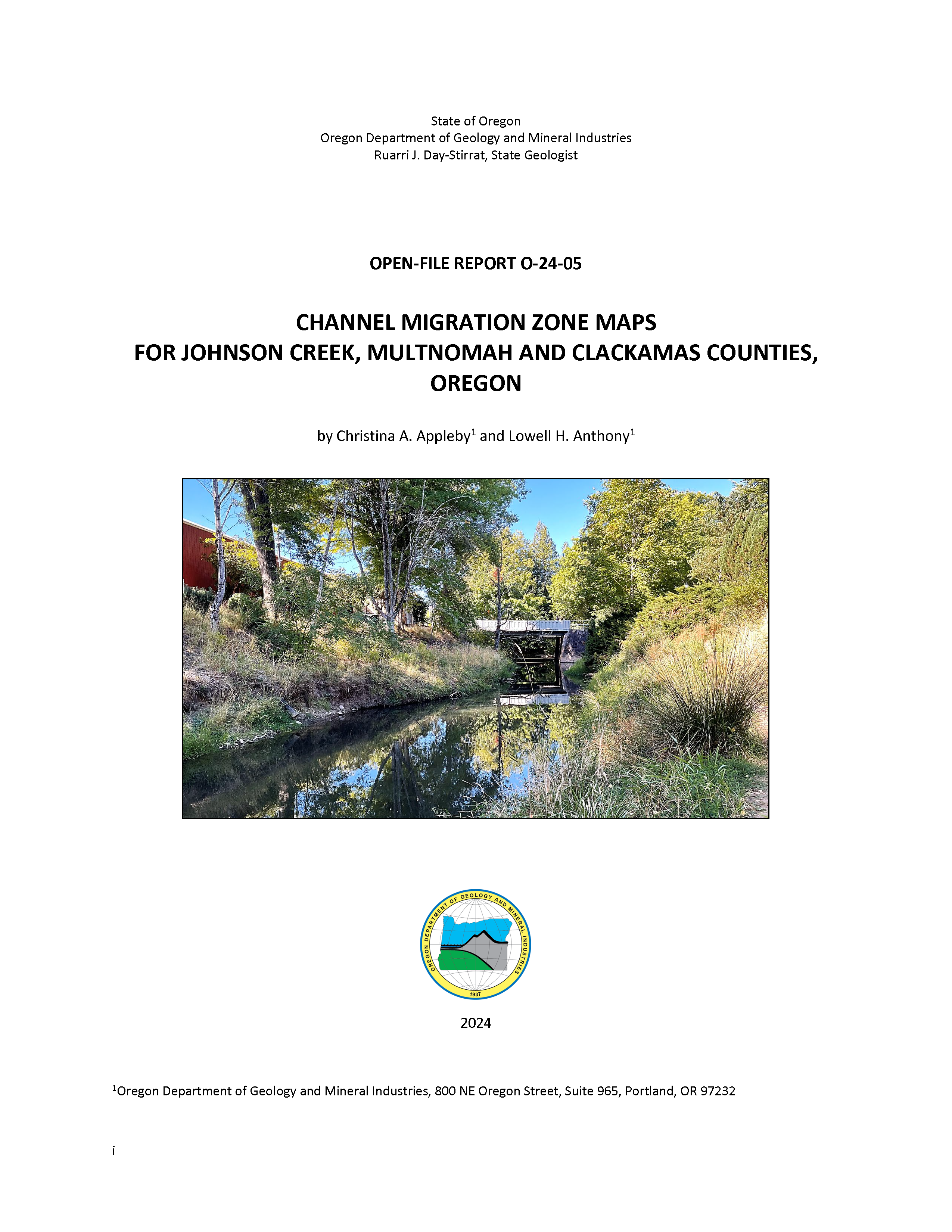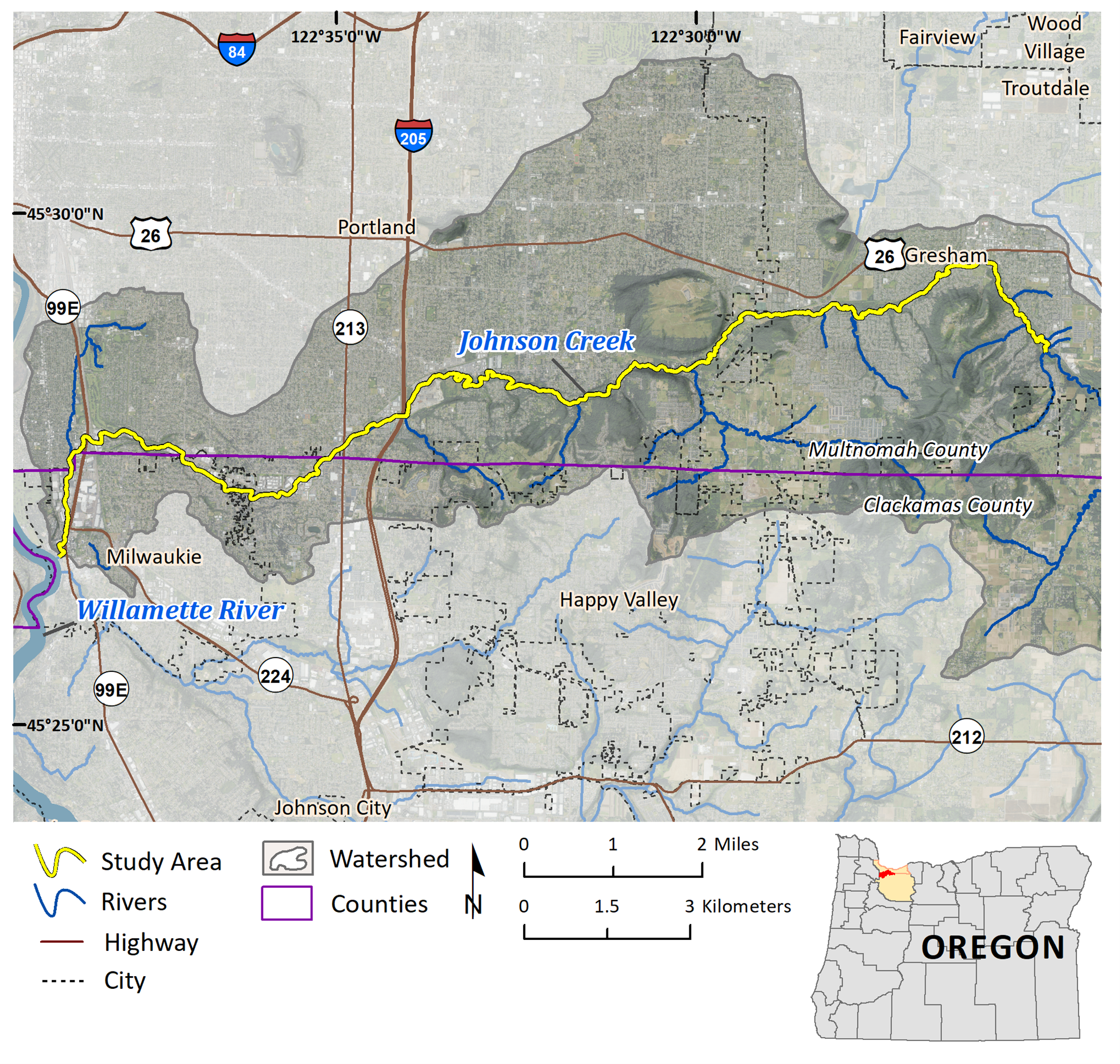DOGAMI OPEN-FILE REPORT SERIES
Publication Preview

Open-File Report O-24-05, Channel Migration Zone Maps for Johnson Creek, Multnomah and Clackamas Counties, Oregon, by Christina A. Appleby and Lowell H. Anthony; 46 p. report, one Esri® geodatabase with internal metadata, external metadata in .xml format, one spreadsheet in Excel format.
WHAT’S IN THIS REPORT?
This report describes the methods and results of channel migration zone mapping for Multnomah and Clackamas Counties, Oregon. These hazard maps show the areas potentially at risk and the accompanying GIS datasets can be used to identify people, buildings, infrastructure, and lands potentially in harm’s way. This information can help communities plan and prepare for natural disasters.
PUBLICATION DOWNLOADS
EXECUTIVE SUMMARY
This study provides Oregon communities with new information about the natural hazards from channel migration. During 2023 and 2024, the Oregon Department of Geology and Mineral Industries (DOGAMI) produced channel migration zone (CMZ) maps for Johnson Creek in Multnomah and Clackamas Counties. These maps are the first of their kind published for this river.
CMZ maps define the area in which a given stream is likely to move laterally and change its channel course in the future. In this study, we mapped CMZs along 17.5 mi (28 km) of lower Johnson Creek. These maps are composed of the active channel, historical migration area, 30-year medium and 100-year low erosion hazard areas, avulsion hazard area, and flagged streambanks. The method used was primarily based on the interpretation of historical aerial photographs, high-resolution lidar topography, geologic maps, and flood inundation maps.
Our results show that, overall, Johnson Creek experienced widespread lateral stability between 1952 and 2022. In the limited areas where channel migration occurred, it was relatively slow (maximum rates within the river segments range from 0.9 ft/yr to 3.5 ft yr (0.3 m/yr and 1.1 m/yr)). Between 2000 and 2022, only 1.5% (~2,800 ft (~850 m)) of the total studied streambanks were visibly, laterally migrating in historical aerial photographs and lidar. The Johnson Creek watershed was heavily modified throughout the 20th century; this included relocating and straightening the channel, making the channel wider and deeper, and replacing the banks and beds with masonry and rock. Historical floodplains were paved and converted into transportation corridors. Although numerous projects have been completed to restore sections of the creek, the impacts of revetment and channelization are still widespread. The observed lateral stability is most likely due to a combination of control from anthropogenic modifications (e.g., berms, bed and bank armoring, channelization) and the naturally low erosive power of Johnson Creek relative to its underlying geology.
These hazard maps and GIS datasets are designed to aid in community planning, raise awareness of riverine flood and erosional hazards, and inform decisions about environmental and emergency management and land use. They may be used to identify which buildings, critical facilities, transportation infrastructure, and utility lines are potentially at risk from channel migration and to prioritize areas for pre-disaster risk reduction. The maps in this study do not replace a site-specific analysis by a land surveyor, geologist, engineer, or some combination thereof. These hazard maps will provide a timely and valuable resource for the county and community planning efforts, including during the development of emergency plans and natural hazard mitigation plan updates.
GEOGRAPHIC INFORMATION SYSTEM (GIS) DATA
Geodatabase is ESRI® version 10.7 format. Metadata are embedded in the geodatabase and are also provided as separate .xml format files.
Each dataset listed below has an associated, standalone .xml file containing metadata in the Federal Geographic Data Committee Content Standard for Digital Geospatial Metadata format.
|
Dataset Type |
Description |
Channel Migration Zone (CMZ)
| This polygon represents the area within which a channel is likely to move laterally during the following 100-years.
|
Active Channel (AC)
| This polygon represents the area within the floodplain that regularly conveys water including the exposed, unvegetated sediment deposits both within and adjacent to the river.
|
Historical Migration Area (HMA)
| This polygon represents the channel has occupied in the historical photographic record, including the active channel.
|
Medium Erosion Hazard Area (EHA)
| This polygon represents the areas with medium potential to be impacted by lateral migration and channel widening during the following 30-years based on maximum historical erosion rates.
|
Low Erosion Hazard Area (EHA)
| This polygon represents the areas with low potential to be impacted by lateral migration and channel widening during the following 100-years based on maximum historical erosion rates.
|
Avulsion Hazard Area (AHA)
| This polygon represents the areas with the greatest potential to be impacted by rapid channel diversion and occupation.
|
Flag
| This polyline represents the channel banks which have been identified for further geotechnical inspection due to signs of recent migration or location directly adjacent to landslide deposits.
|
Study Area
| This polygon represents the study area extent.
|
Study Area
Figure 1 1. Study areas (highlighted in yellow) within a subsection of Multnomah County and Clackamas Counties, Oregon. The context map shows the location of Multnomah and Clackamas Counties (in light orange) with the Johnson Creek watershed (in dark orange).
